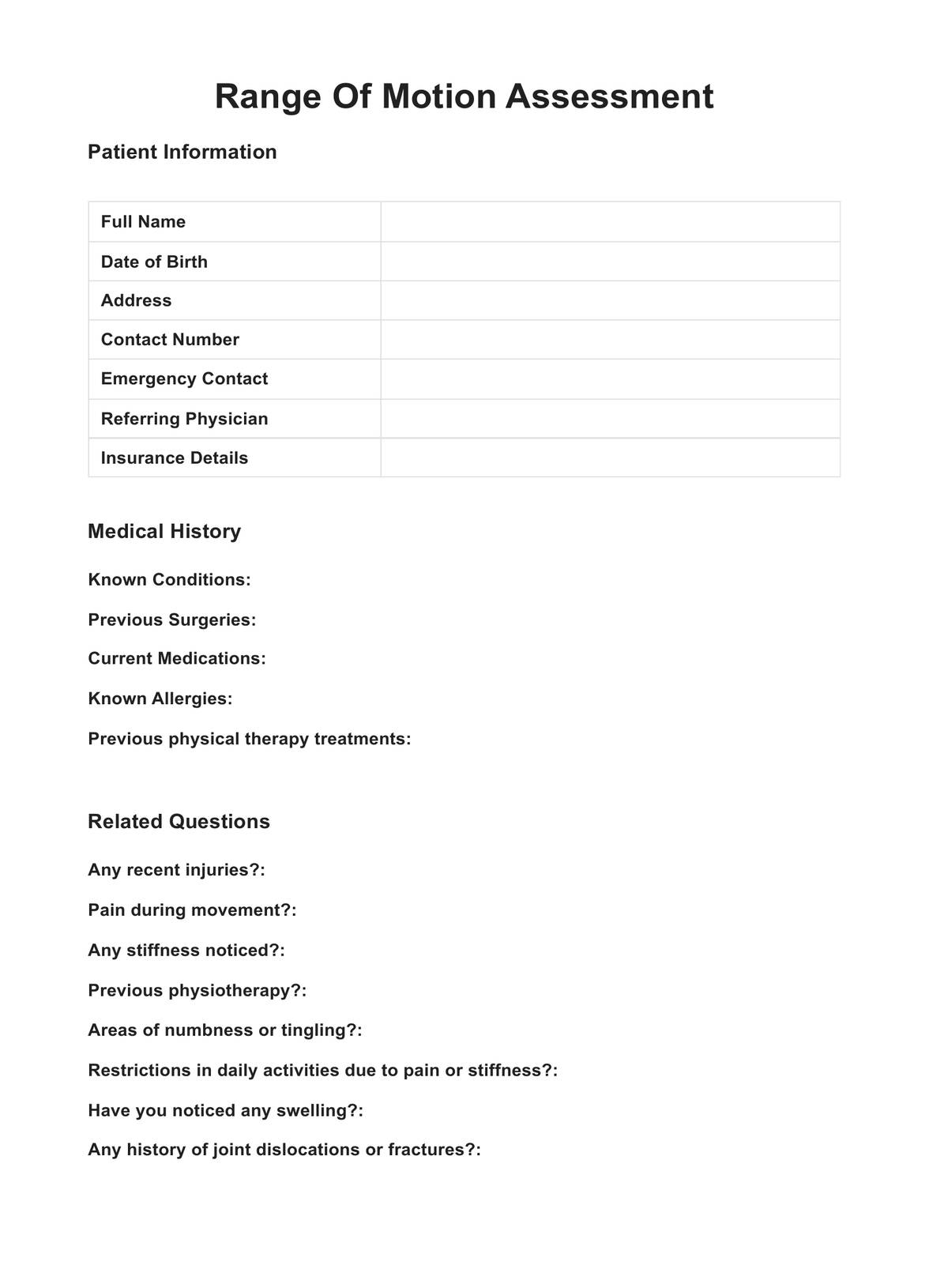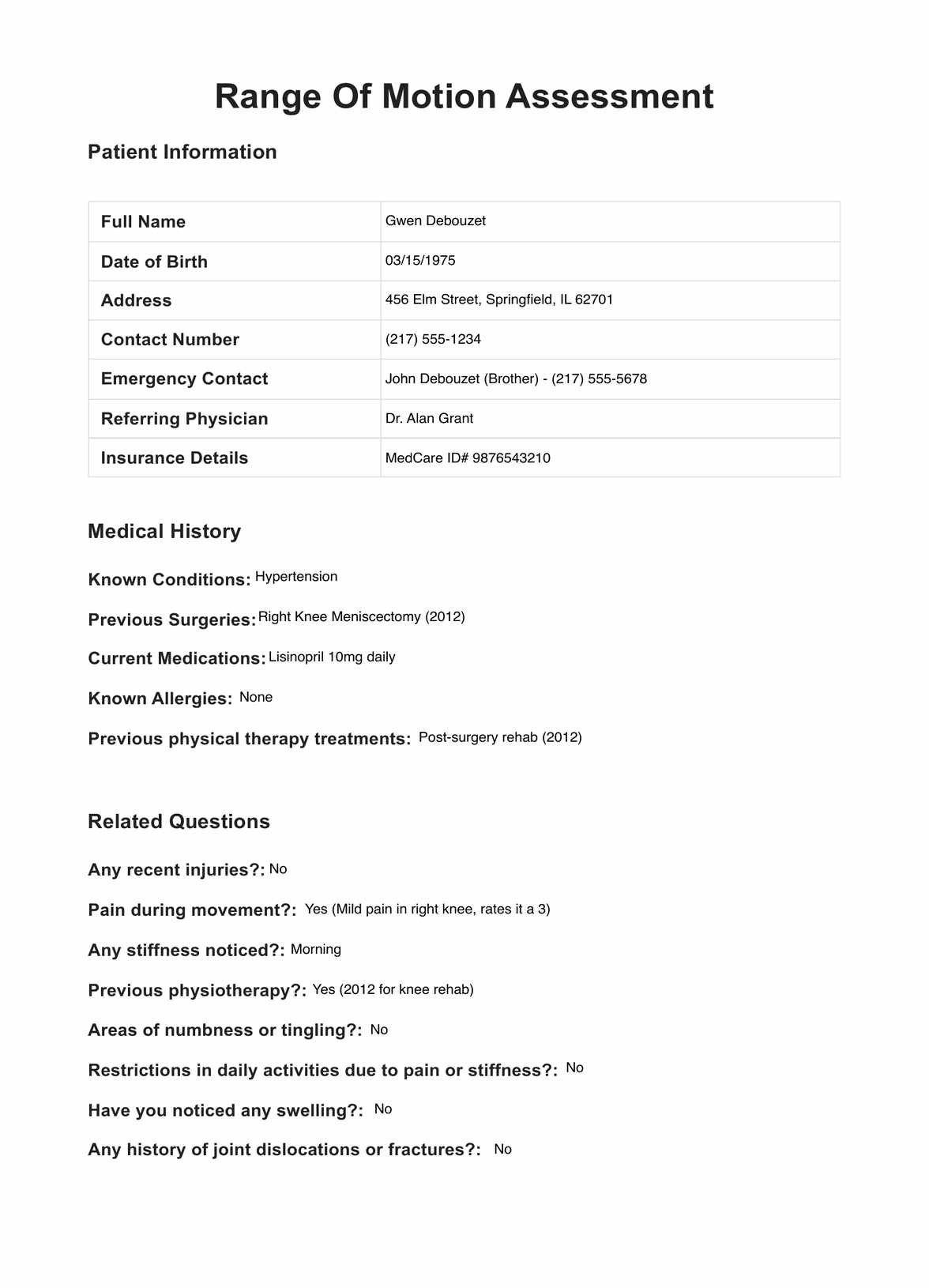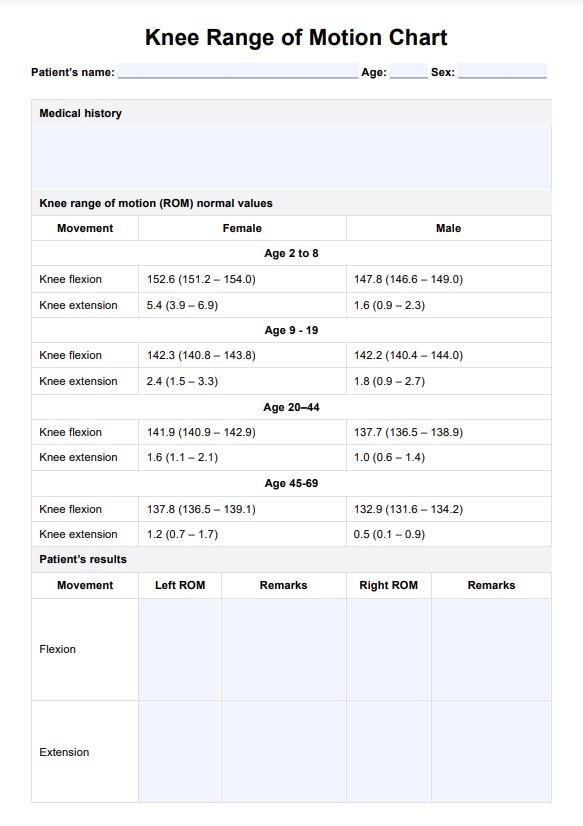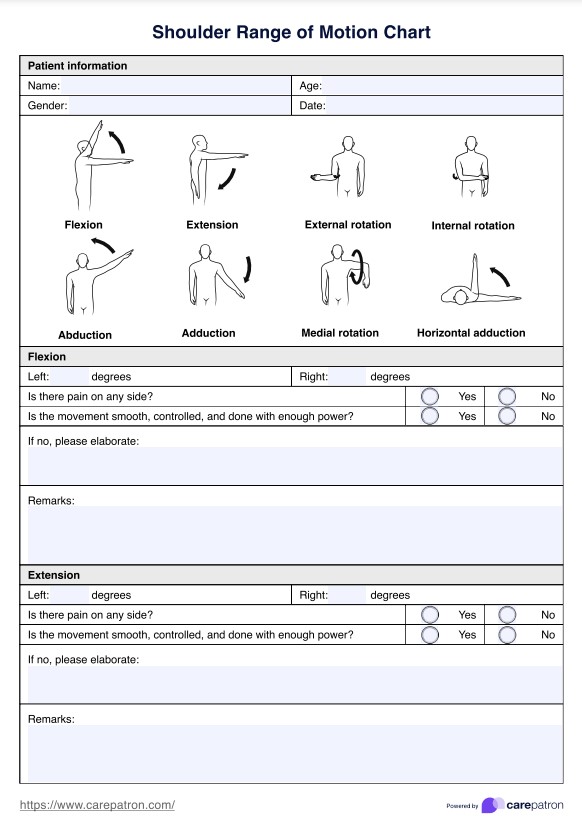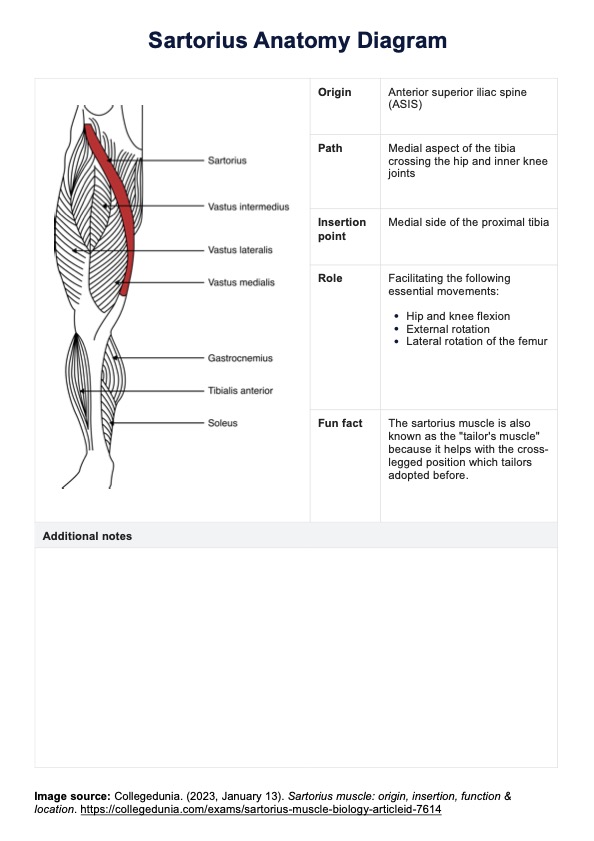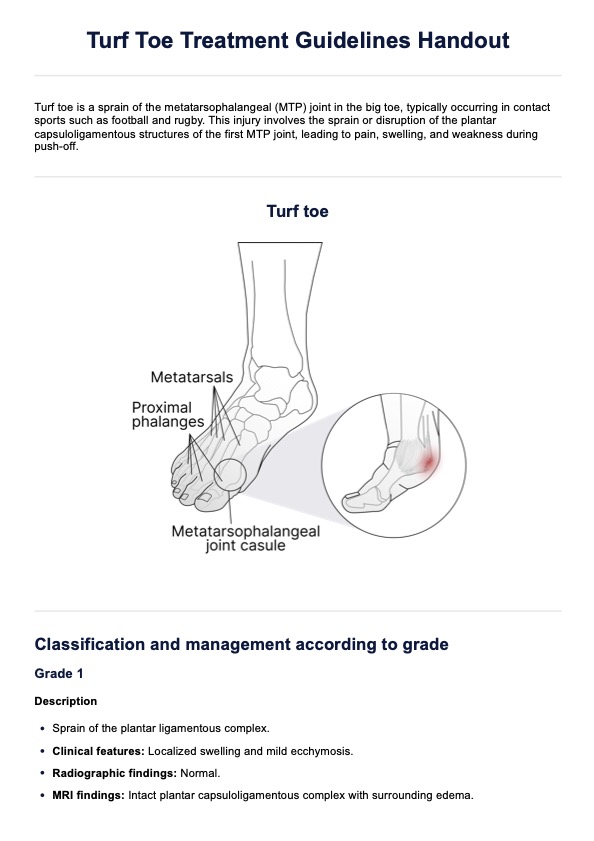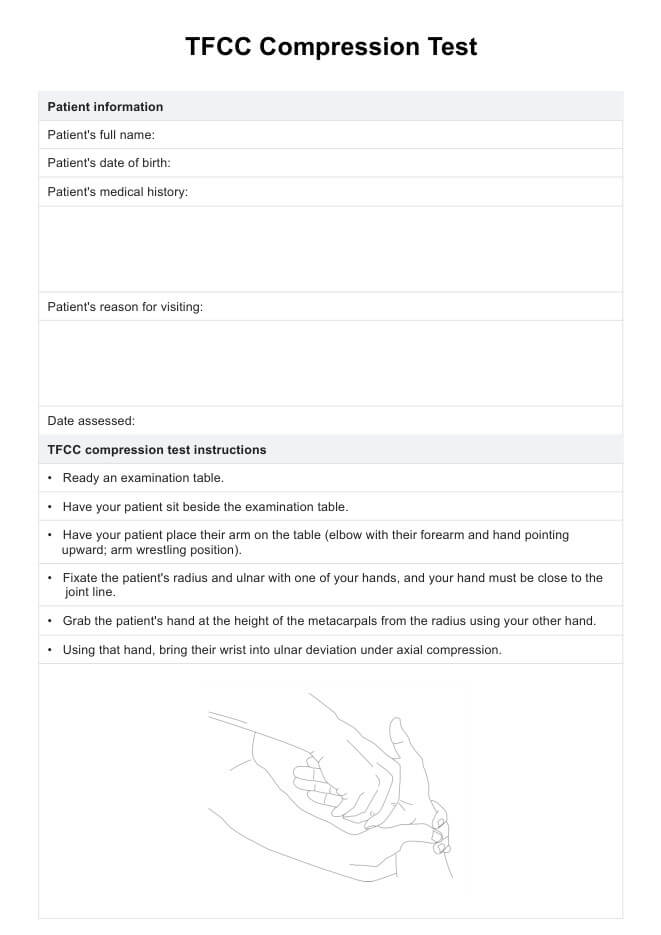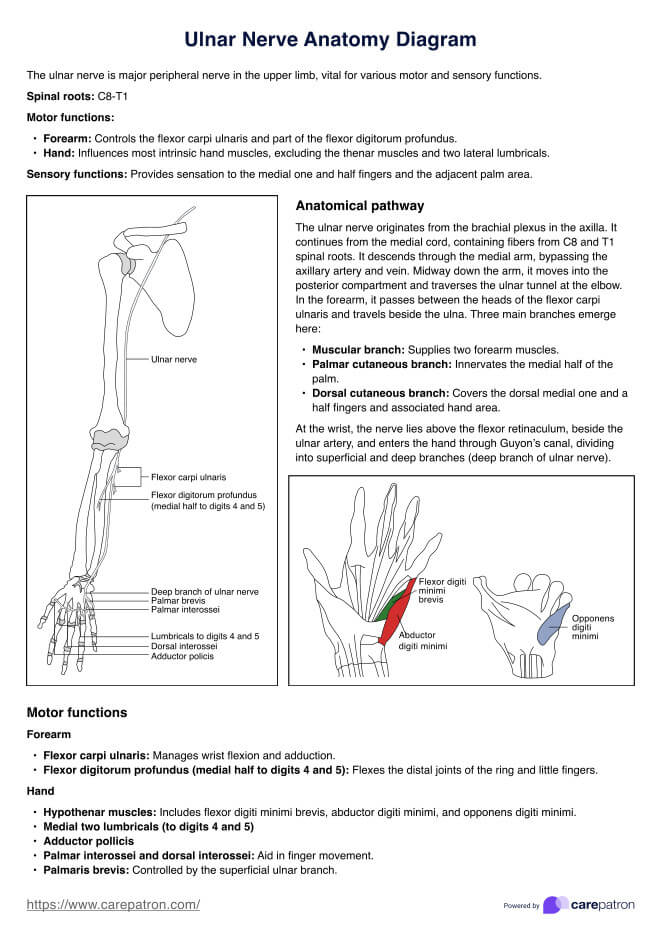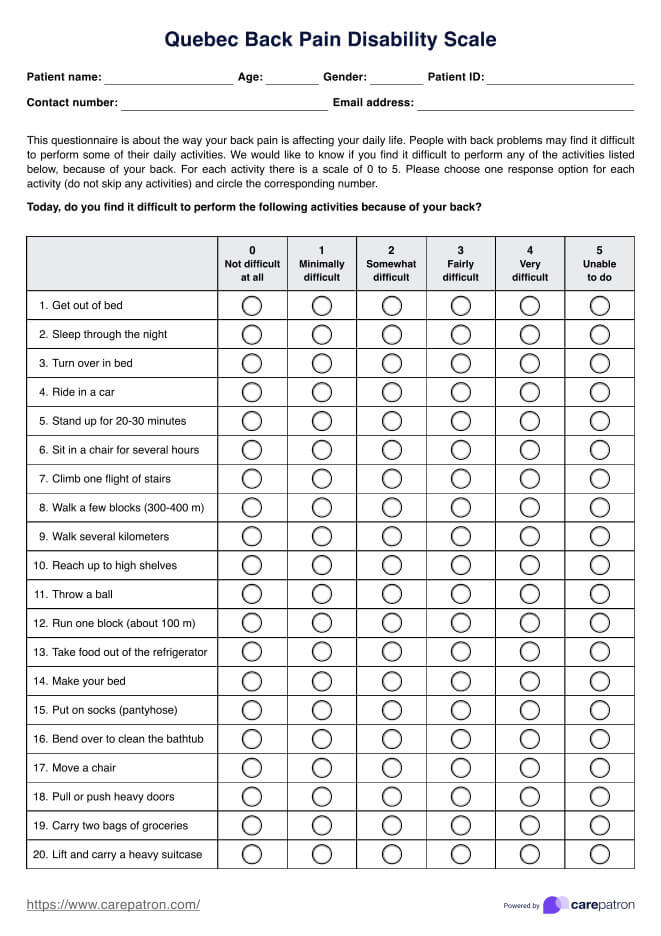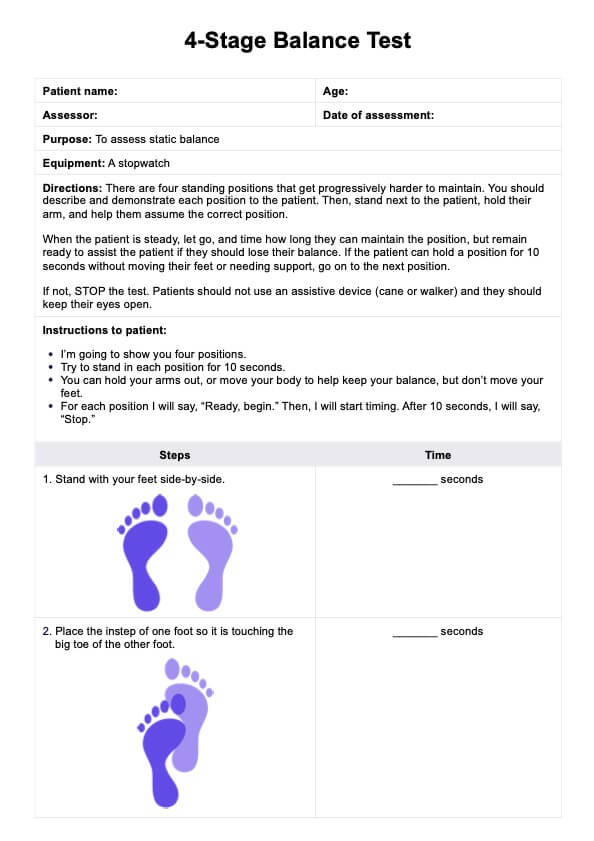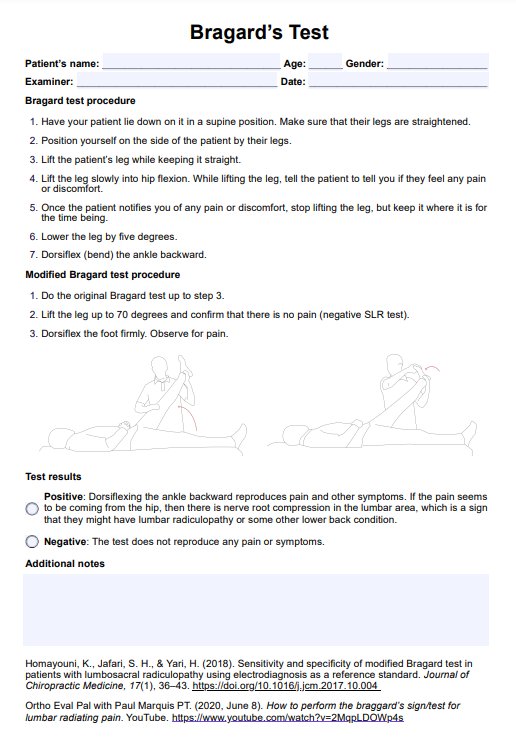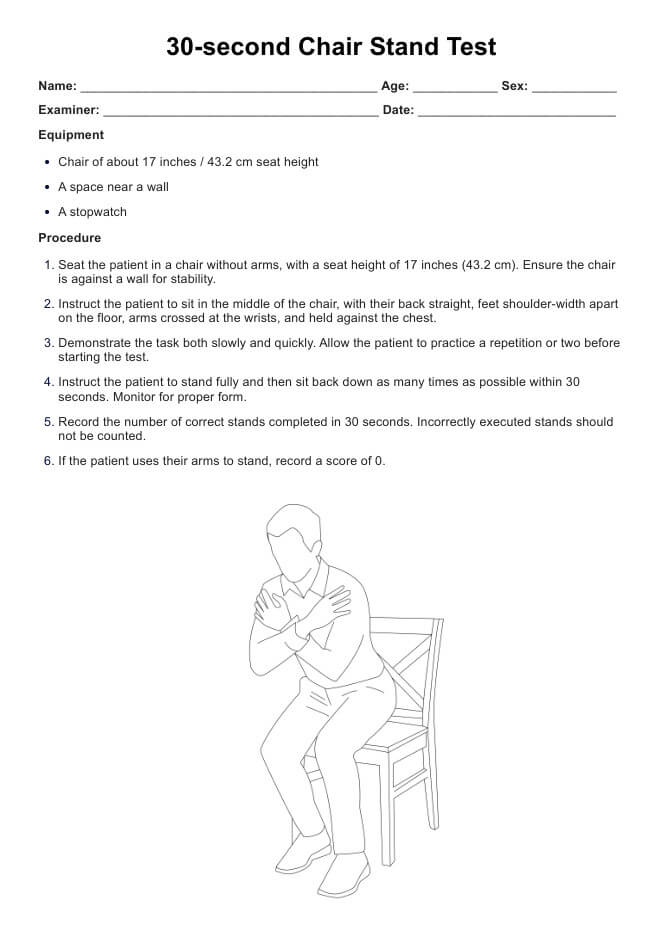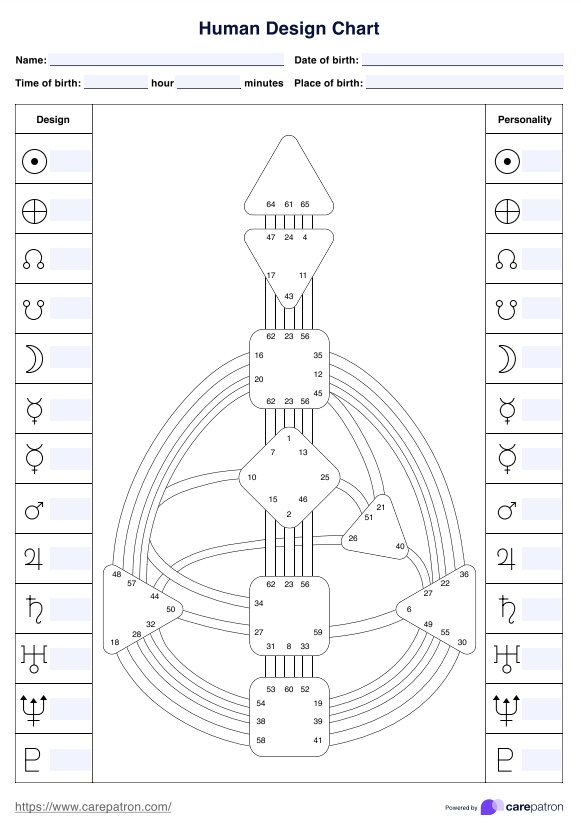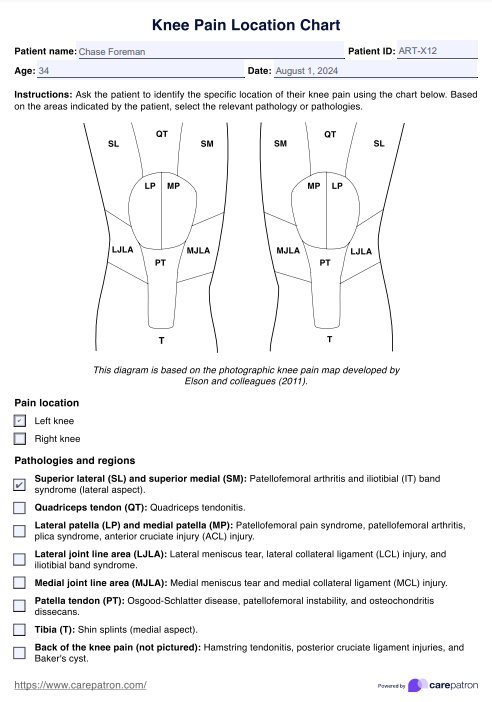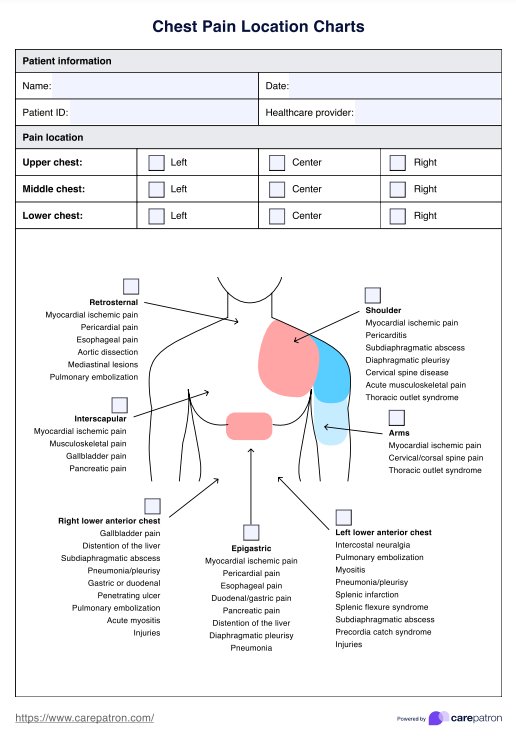Range Of Motion Assessment
Dive into the revolution of assisted living care with Carepatron. Discover the comprehensive Range Of Motion Assessment guide, and enhance your care professionalism today.


What is a Range of Motion Assessment?
Have you ever experienced stiffness or discomfort in your joints that hindered your movement? Perhaps you've struggled to bend your knees fully or reach for something above your head without feeling restricted. These everyday challenges highlight the importance of understanding our body's Range of Motion (ROM).
When you visit a physical therapist, they might perform a Range of Motion Assessment to evaluate how well your joints move. This assessment is crucial for determining if any limitations or abnormalities in your joint mobility could impact your daily activities or athletic performance.
During a ROM assessment, the physical therapist will carefully observe and measure the movement of each body part. They may use various techniques to assess both active ROM, where you move your joints independently, and passive ROM, where the therapist moves your joints.
For instance, they might ask you to bend your knees as far as possible or lift your leg to the side (hip abduction). They'll also gently manipulate your joints to check their flexibility and assess passive range.
Using tools like a goniometer or a tape measure, they'll precisely measure joint angles to determine your ROM values. These measurements help them identify deviations from normal values and pinpoint areas of concern.
As they measure ROM, the therapist will note any limited range of motion, painful symptoms, or difficulties you experience. They may also apply external force or provide partial assistance to help you achieve maximum range in specific movements.
ROM measurement isn't just a one-time test. The measurement procedure can be repeated to monitor progress and assess the effectiveness of treatment interventions.
By understanding your body's ROM, physical therapists can tailor exercise physiology programs to improve flexibility, strength, and overall joint function. Techniques like static stretching or cyclic passive stretch repetitions can help lengthen muscles and improve tissue resistance, enhancing mobility and reducing the risk of injury.
Range Of Motion Assessment Template
Range Of Motion Assessment Example
How does it work?
When a patient like Gwen Debouzet visits a physical therapist for a Range of Motion (ROM) Assessment, it's essential to have a straightforward, step-by-step approach to ensure an accurate evaluation. Here's a detailed breakdown:
Step 1: Patient introduction
In conducting a ROM assessment, the process begins with a warm greeting to establish rapport with the patient, followed by an explanation of the assessment's purpose and benefits. This step is crucial for setting a comfortable environment conducive to practical evaluation.
Step 2: Gather patient information
Next, gather essential patient information such as name, date of birth, address, emergency contact details, pertinent insurance information, and the name of their referring physician.
Step 3: Take a comprehensive medical history
Following this, take a comprehensive medical history, delving into details about known conditions, prior surgeries, current medications, and allergies. Additionally, inquire about any previous experiences with physical therapy treatments.
Step 4: Pose relevant questions
Pose relevant questions to the patient regarding recent injuries, pain experienced during movement, stiffness, numbness, and previous physiotherapy encounters. Determine the extent to which these issues restrict the patient's daily activities.
Step 5: Begin the physical assessment
Proceed to the physical assessment phase, where the patient will perform specific movements to gauge their active tests ROM. For different joints, passive ROM evaluation gently moves the patient's joints through their full range of motion while they remain relaxed. Document any findings, paying close attention to any restrictions or discomfort noted during the assessment.
Assessing range of motion (ROM) typically involves using a device called a goniometer, which is designed to measure the angle of a joint.
Step 6: Interpretation and recommendations
After completing the assessment, interpret the gathered data to identify patterns and specific issues affecting the patient's joint function and mobility. Based on these findings, provide recommendations for therapeutic interventions or suggest follow-up assessments if necessary.
Step 7: Discuss findings with the patient
Discuss the assessment findings with the patient, reviewing any notable restrictions or concerns identified during the evaluation. Emphasize the benefits of the recommended therapeutic interventions in addressing these issues and improving joint function and mobility.
The ROM assessment is vital in understanding a patient's joint function and mobility. By following a structured approach and utilizing warm-up exercises and measurement protocol techniques, healthcare professionals can effectively identify issues, implement injury prevention strategies, and optimize sports performance.
When would you use this form?
Accurate assessment is the cornerstone for developing effective physical therapy and rehabilitation treatment plans. But when exactly should a practitioner utilize the Range of Motion Assessment?
- Understanding a new patient: Understanding their baseline ROM is crucial when a new patient walks in. This ensures that any deviations or restrictions from the norm are immediately flagged.
- Post-surgery rehabilitation: A ROM Assessment helps track progress and guides the rehabilitation process after orthopedic surgeries, especially joint replacements or reconstructions.
- Trauma or injury: After trauma or an acute injury, this form aids in evaluating the immediate impact on joint mobility, helping to craft short-term management plans.
- Chronic musculoskeletal disorders: For conditions like osteoarthritis or rheumatoid arthritis, regular ROM assessments can track the progression of the disease and the efficacy of ongoing treatments.
- Evaluating treatment efficacy: If a patient is undergoing physical therapy, reassessing their ROM can give objective data on whether the treatment is beneficial.
- Discharge evaluations: Before discharging a patient from therapy or rehab, a final ROM assessment can provide data to compare with the initial findings, showcasing the improvement.
The Range of Motion Assessment isn't just a one-time tool. Its utility spans from the initial evaluation through the therapy process and all the way to discharge.
Benefits of using the Range of Motion Assessment template
The Range of Motion Assessment is not just a mere form; its systematic layout provides multifaceted benefits to healthcare professionals. Here's how this template can revolutionize your assessment process:
Streamlined evaluations
The comprehensive format ensures that all pertinent joint areas and associated concerns are covered, leading to a more efficient patient evaluation.
Standardized documentation
A consistent template guarantees that assessments are uniform across all patients, making it easier to compare, track, and interpret results over time.
Improved patient communication
A structured form can serve as a discussion guide, fostering better patient-therapist interactions and ensuring patients fully understand their progress and challenges.
Objective data collection
With set criteria and scales, this template assists in gathering quantifiable data, which is critical for tracking progress and measuring treatment efficacy.
Enhanced professionalism
A well-organized and thorough template enhances the therapist's professionalism, instilling greater patient confidence and trust.
Ease of training
This template is an educational tool for budding physical therapists, aiding in learning the ropes of assessments and ensuring they take all vital steps.
Research and evidence
The importance of measuring Range of Motion (ROM) is firmly rooted in the history of physical therapy and orthopedic medicine. A comprehensive assessment of joint mobility is a cornerstone in evaluating functional capacity, determining deficits, and planning rehabilitative interventions.
Historically, the significance of ROM assessments has been documented as far back as the early 20th century. It was recognized that mobility restrictions could profoundly affect an individual's quality of life and functional independence. Over time, standardized methods, such as goniometric measurements, were developed to ensure objective and reproducible results.
Research has continually underscored the relevance and reliability of ROM assessments. A study published in the Journal of Orthopaedic & Sports Physical Therapy emphasized ROM measurements' critical role in diagnosing, treating, and prognosticating outcomes in musculoskeletal conditions. It highlighted the need for a structured and consistent assessment approach, much like the discussed template.
Further evidence in the Archives of Physical Medicine and Rehabilitation has also underlined the correlation between ROM deficits and functional impairments. This strengthens the argument for routine ROM assessments to predict and address potential operational challenges.
Moreover, from a legal and ethical perspective, accurate documentation, like our ROM template, is paramount. It records patient progress, justifies treatment modalities, and is essential for reimbursement processes.
With its deeply rooted historical significance and substantial research backing, the Range of Motion Assessment is an indispensable tool in modern physical therapy and orthopedic practice. It blends tradition with evidence-based practice, ensuring patients receive optimal care based on objective and standardized evaluations.
References
Clarkson, H. M. (2000). Musculoskeletal assessment: joint motion and muscle testing. Lippincott Williams & Wilkins.
Magee, D. J. (2014). Orthopedic physical assessment. Elsevier Health Sciences.
Neumann, D. A. (2009). Kinesiology of the musculoskeletal system: foundations for physical rehabilitation. Elsevier Health Sciences.
Norkin, C. C., & White, D. J. (2016). Measurement of joint motion: A guide to goniometry. F.A. Davis Company.
Reese, N. B., & Bandy, W. D. (2016). Joint Range of Motion and Muscle Length Testing. Elsevier Health Sciences.
Roach, K. E., & Miles, T. P. (1991). Normal hip and knee active range of motion: the relationship to age. Physical Therapy, 71(9), 656-665.
Smith, L. K., Weiss, E. L., & Lehmkuhl, L. D. (1996). Brunnstrom's clinical kinesiology. F.A. Davis Company.
Commonly asked questions
ROM testing involves assessing the extent of joint movement to determine the flexibility and mobility of a specific joint.
ROM is measured using a goniometer or similar device, which quantifies the angle of joint movement during specific motions.
Limited ROM suggests restricted joint mobility, which may indicate underlying issues such as stiffness, muscle tightness, or joint injury.


